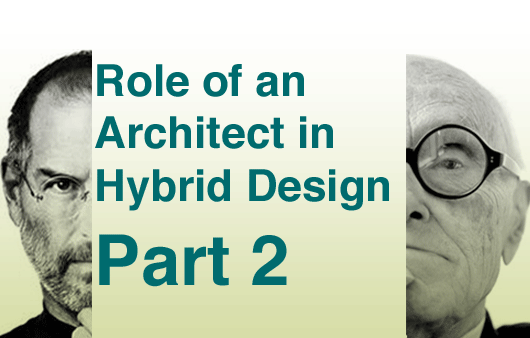
Role of the Architect in Hybrid Design: Part 2
Looking back on a computer programming class in my high school days, I remember a difficult problem which I could not easily solve. Frustrated, I told my instructor “I quit, I am going to be an architect; I do not need to know computer programming.”
…man was I wrong!
The role of computers in the field of architecture has grown at an exponential rate. It started with Simple CAD, a digitized version of the way architects had already been working for ages. More recently BIM has been introduced, which some say saves time, and money by using the computer to create more coordinated 2d drawings of a 3d model. CAD and BIM however still rely on old methods of design thinking, in which a form is created and an architect inputs this into a computer program which then outputs instructions on how this is to be built. A new method of computer aided design is called “computational design”, which introduces the computer at the beginning stages of the design process and uses it through the construction period. Computational design is more about designing a process, than just designing a form.
Computational design has its critics, who feel that computers are replacing architects. In computational design architects are no longer a slave to computer processes, they are in turn creating them. Computational design is rooted in the constraints of physics, construction materials, and the fabrication process. Parameters are defined by the designer before a form is created.
For example, an architect would input the maximum size of a certain construction material, also what types of connections are physically possible to join two pieces of this material, and the limitations of the machine fabricating these pieces. Once this type of information is input into the program, the architect can change many variables, automatically altering the form of the structure while still fitting into the parameters of construct-ability.
“Computational design not only necessitates learning new technical skills, above all it requires that we re-think tried and true conventions rooted at the core of architectural practice.” Achim Menges – Detail Vol 4 2010
What does computational design mean for architects?
You won’t necessarily need to become a computer programmer who inputs hundreds of lines of code to use it. The most important thing is to change your design process. Tools such as Grasshopper for Rhino are visual programming languages, which means that the process is designed graphically by arranging functions into a type of bubble diagram. This process is then linked to a Rhino file which is automatically adjusted when specific variables in the process are changed. The Rhino file can then be exported directly to a CNC machine for fabrication.



The architect in this type of computational design, must be constantly thinking of the end product during the design process. No longer can we create forms, without first thinking about how it will be built. We will create more efficient buildings, because our designs will consider structure, fabrication, and form from the beginning stages.
Below is a quick demonstration of the basic capabilities of a computational design process.
-Dan



